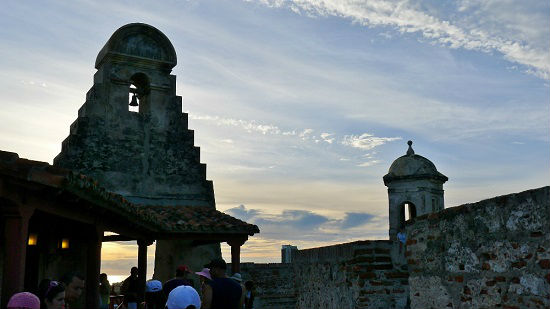

Try to imagine dozens of treasure galleons slicing their way across the Atlantic to Spain, their cargo holds packed with gold, silver, tobacco, cacao (chocolate) beans and chile peppers from the mines and plantations of the New World.
Sailing under the fiery red cross of the Holy Roman Empire, some of the ships’ voyages began at the Colombian port of Cartagena, where they left in convoys to ward off pirates. At Havana, they joined convoys of other galleons from the Mexican port of Veracruz, doubling their firepower before crossing the central Caribbean’s brigand-packed waters on the last leg of their trip to Spain.
The shipments started in the 1560s and went on once or twice a year for more than two centuries. Early on, Cartagena – brimming over with profits from the shipping business but with virtually no defenses – was a sitting duck for the pirates. The Jolly Rogers of Sir Francis Drake, John Hawkins, Henry Morgan and their chums were no strangers to the city’s inviting bay.
Cartagena was likely the most plundered port in the New World until Spain got its act together to defend the city. The fix was to circle Cartagena with a seven-mile-long wall studded with gun turrets backed up by forts in key locations. The tab was the equivalent of a whopping 2 trillion bucks in today’s U.S. dollars. Yes, 2 trillion – about the cost of 100 U.S. aircraft carriers!
It’s hard to miss the monster fortress of Castillo San Felipe de Barajas towering over the city atop a 130-foot-high hill. Originally built in the mid-1600s, the crown jewel of the defense network was rebuilt and enlarged several times over the years to become the greatest fortress Spain ever built in its colonies.

English Admiral Edward “Old Grog” Vernon, fresh from a victory at another Spanish port at Portobelo, Panama, found out how tough the Cartagena fortress was when he tried to capture the city in 1741. It’s said Old Grog “darkened the sea” with an invasion fleet of 186 ships, their 2,000 cannons blasting away at the fort as his army of 23,000 Brits tried over and over to scale its walls. But Castillo San Felipe – defended by just 3,000 Spanish troops and six ships – stood off a month-long siege. The fort proved to be impregnable.
The Spanish victory at Cartagena was one of the greatest defeats of the Royal Navy. Also red-faced after the battle were 4,000 American colonists from Virginia who fought for Admiral Vernon under the command of Lawrence Washington, half-brother of George Washington.
Looking much like a mountain of concrete, the fortress is in remarkably good shape. Visitors rub elbows with thousands of other tourists climbing its walkways (it takes about 15 minutes to get to the top), scampering around its bunkers, batteries and tunnels and posing for pictures on its cannons. From the highest level it’s easy to see how sharp-eyed Spanish gunners could blast enemy ships down in the bay, and in another direction pick off soldiers trying to attack the fortress on foot.

Another eye-popping view from the top of the fortress is a panorama of this city of a million or so people. In one section you’ll spot modern high-rise condos, in another the domes and soaring crosses of historic churches, and in another rows of glassy office buildings.
Andalusia in Colombia
Down on the ground, visitors to Cartagena are invited to take a trip back to its colonial elegance by wandering around “Old Town” behind the city walls. You’ll stroll through cobbled lanes lined with buildings painted in pastel blues, greens, yellows, reds, pinks and browns, many of them the mansions of shipping barons and bankers in the years of the treasure fleets.
Adding to the Andalusian fantasy of Old Town’s seemingly endless blocks are elaborately decorated arched doorways and balconies with flowers poking through iron railings and lattices. You’ll saunter by charming al fresco restaurants, all kinds of bars, museums, churches, convents and statues of Colombian heroes. And don’t miss a look at the dark side of old-world Spain in the Palace of the Inquisition.
Need a rest? You’re welcome to join the local folks snoozing or chatting on benches around the area’s magnificent squares and parks while musicians, jugglers, clowns, mimes and the like pass by, hoping to earn tips of a few pesos.

Staying there: Cartagena offers better than 90 tourist-class hotels in and around the city.
If You Go
Proexport (Colombia’s tourism, foreign investment and export promotion agency) www.proexport.com.co.
- Top 10 Things to Do in Ireland - April 25, 2024
- How to Get Around in Sydney: A Local’s Guide to Traveling Around Sydney - April 24, 2024
- The Low-Key Magic of Ghent, Belgium - April 22, 2024
